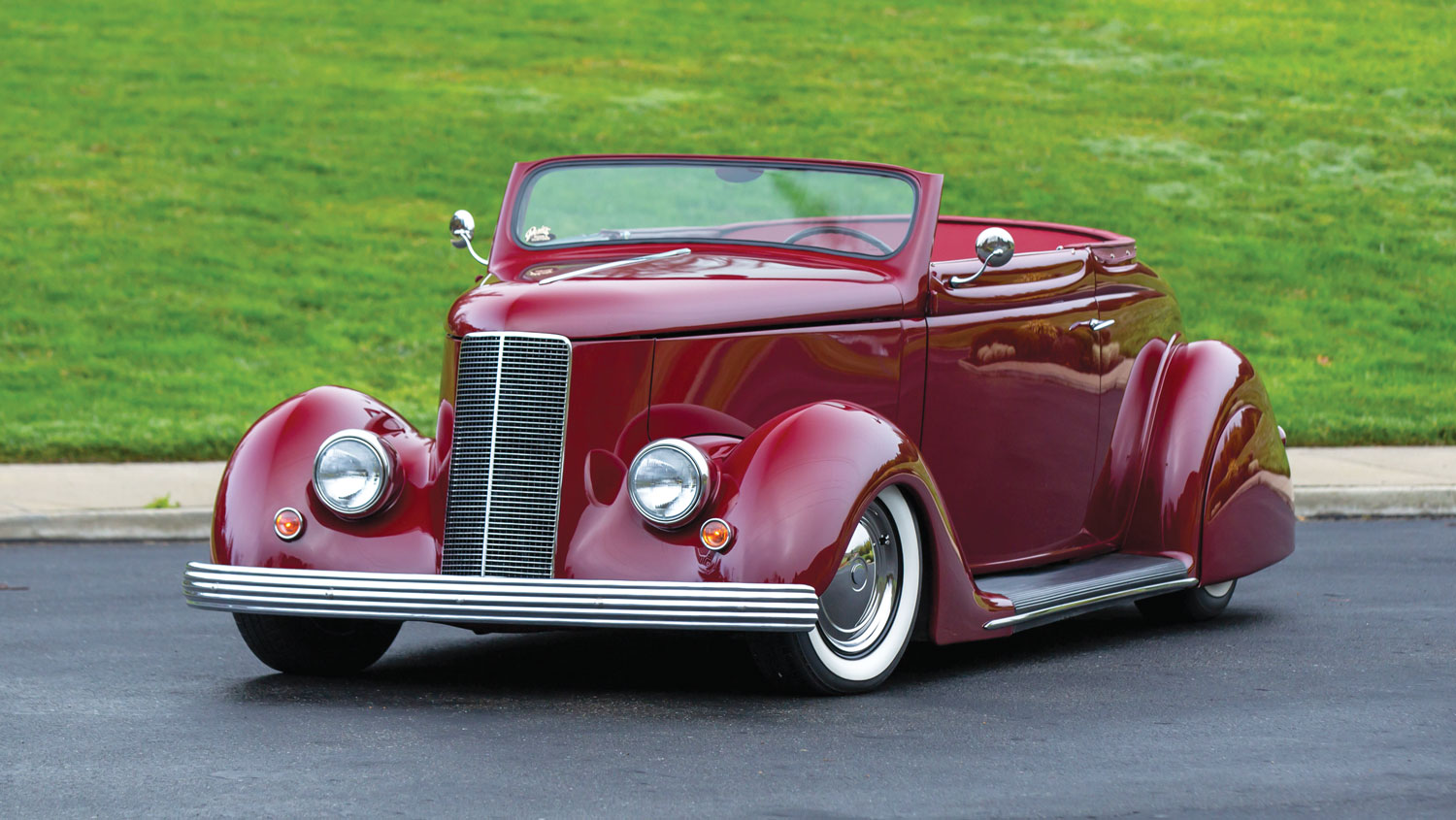- First car built by Ken “Posies” Fenical for his shop, Posies Rods and Customs, Hummelstown, PA
- Chopped 3.5 inches, with a Carson-style padded top
- 350-ci small-block Chevrolet V8 with three Rochester 2-bbl carburetors
- Featured in over 20 hot rod magazines worldwide
- Built in 1981 and restored in 2011.
- Known as “The Smooth ’36”
SCM Analysis
Detailing
| Vehicle: | 1936 Ford Cabriolet |
| Years Produced: | 1936 (Mecum states this car is a 1935 model, but the serial number is from 1936) |
| Number Produced: | 17,000 DeLuxe Cabriolets in 1935 |
| Original List Price: | $625 |
| SCM Valuation: | $33,500 |
| Tune Up Cost: | $300 (estimated) |
| Chassis Number Location: | Originally stamped on the frame rail near the firewall, driver’s side |
| Engine Number Location: | Pad ahead of passenger’s side cylinder head (Chevrolet small-block) |
| Alternatives: | Other ’30s- to ’40s-era period custom rods |
| Investment Grade: | C |
This car, Lot F66, sold for $63,800, including buyer’s premium, at Mecum’s Glendale, AZ, auction on March 13, 2020.
Customizing — the art of restyling and updating an older-model car — began in the 1920s and arguably peaked in the late 1950s. Classic pioneer customizers such as Jimmy Summers in Los Angeles and Harry Westergard in the Bay Area chopped, de-chromed and lowered 1930s- to 1940s-era Fords and Chevys, utilizing trim and accessories from other makes to give their subjects a distinctive, classy appearance.
These original custom practitioners were succeeded by Gil and Al Ayala in East L.A., the prolific Barris Brothers in Lynwood, CA, Joe Bailon in Oakland, CA, and many imitators. Convertibles and roadsters were enhanced with chopped, padded tops built by Glen Houser’s Carson Top Shop or Bill Gaylord in Los Angeles and Hall’s Top Shop in Oakland, CA.
The customizers moved on to 1949 to 1951 Mercurys as their starting points, but the more-affordable early cars stayed popular as well. However, by the 1970s, the movement had waned.
Looking in the rear-view mirror
Ken Fenical, better known as “Posies” because his parents owned a flower shop, built this chopped Ford cabriolet in 1981 and helped jumpstart a period custom-car renaissance.
Seeking a ’40s look, he chopped the top, faired in the headlamps, lowered the car considerably and installed 1937 DeSoto ribbed bumpers and a ’49 Chevy license-plate guard, as early-time customizers might have done. Posies then built a front-lifting “alligator style” hood and solid hood sides. The pièce de résistance was a vertical ’37 LaSalle grille.
The original interior was redone in white tuck-and-roll Naugahyde over modern seats. The dash was originally molded in, painted the same color as the car, and fitted with Stewart-Warner gauges. Air conditioning was a modern upgrade, at least for the time this car was originally built.
Power to the people
For reliability, Posies updated the drivetrain with an L81 Chevy Corvette V8 fitted with a three-carburetor manifold and finned valve covers. He also fitted an automatic transmission. The original Ford frame was strengthened and fitted with a 1968 Chevrolet Nova front subframe and a 1965 Ford Mustang rear end.
Turning it all was a rare 1950 Ford Crestliner wheel fitted to a contemporary steering column. This car’s major distinguishing features included a low, white Carson-style padded top, teardrop fender skirts, twin Appleton spotlights and a dazzling bright Sunfire Yellow finish.
Worldwide acclaim
The throwback custom was an immediate hit, featured in many magazines, and it spawned a host of imitators. A few years ago, Posies told me, “People had forgotten what the past was all about. This cool custom reminded them. My touch was the LaSalle grille shell, but I flipped it upside-down so it mated perfectly with the hood-line. And I lowered the spare instead of removing it.”
Although traditional customs were almost always dropped more in the rear, Fenical noticeably lowered the front of his cabriolet a touch more than the back. “As a hot-rodder,” he said, “I didn’t appreciate taildraggers and I still don’t. My car was featured in 28 worldwide publications,” he noted proudly, “a phenomenal feat at the time.”
Time for a change?
Over the years, a subsequent owner redid the top and interior in blue, and a third owner refinished the cabriolet in Madeira Maroon with a black top and removed the twin spotlights, as it appears today. The cabriolet sits level now, more in keeping with custom-car practice. And the steering wheel and dashboard are from a 1940 Ford.
Where ’35 and ’36 Fords are concerned, roadsters are rarer and more popular than cabriolets, but this car’s history in the custom-car world sets it apart and commands a value that’s somewhat higher than that of a stock Ford DeLuxe cabriolet.
You certainly couldn’t build this car for $63,800, and that doesn’t begin to cover its notoriety. I do wish it were still Sunfire Yellow, in which case it might have brought even more. But in these uncertain times, I think it was a good deal for the seller and the buyer both.
(Introductory description courtesy of Mecum Auctions.)
